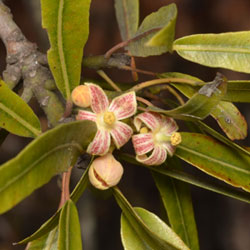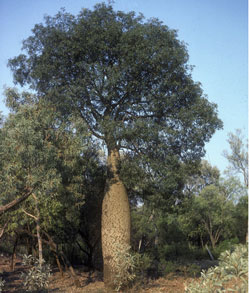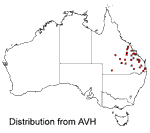Brachychiton rupestris
 |
 |
Queensland Bottle Tree
Brachychiton rupestris (T.L.Mitch. ex Lindl.) K.Schum.
Brachychiton rupestris is a member of the Sterculiaceae family and is commonly referred to as the Queensland Bottle Tree, Queensland-Flaschenbaum, or the Narrowleaf Bottle Tree or Kurrajong. The common name “bottle tree” refers to the characteristic trunk of the tree, which can reach a 2 m diameter. The height of the tree is less impressive, with a maximum height of 18-20 m, smaller in cultivation; the canopy spans 5-12 m in diameter. The tree will drop its leaves before the flowering period, which are between the months of October and December. The characteristic bottle shape should develop in approximately five to eight years. The canopy will also thin out during a drought.
 The species is endemic to a limited region of Australia namely Central Queensland through to northern New South Wales. It grows in a soil that consists of a medium to heavy clay, silt, sand and volcanic rocks. Yet the tree is quite hardy and can tolerate a variety of climates and soil types . It has been cultivated in southern Australia for many decades and can be seen as an ornamental feature around the world.
The species is endemic to a limited region of Australia namely Central Queensland through to northern New South Wales. It grows in a soil that consists of a medium to heavy clay, silt, sand and volcanic rocks. Yet the tree is quite hardy and can tolerate a variety of climates and soil types . It has been cultivated in southern Australia for many decades and can be seen as an ornamental feature around the world.
The species can be cultivated either by seed or transplantation. When collecting the seed it is important to wear gloves as the exterior of the seeds have irritating hairs. No preparation is necessary before the seed is planted. Transplantation requires minimal soil preparation. The trees, even decades old, can tolerate robust transplantation. Plants have survived a period of three months between removal and it being planted in its new location. This ability allows it great opportunity to be shipped from its Queensland home to different parts of the world.
In terms of horticultural benefits the Queensland Bottle Tree serves not only as an ornamental feature but also provides wind protection and shade. Yet the value of Kurrajong reaches beyond the aesthetics and serves to sustain people and animals alike in times of need. The name of the bottle tree can be taken literally, as there is a significant amount of water stored between the inner bark and the trunk. Aboriginals historically carved holes into the soft bark to create reservoir-like structures. The seeds, roots, stems, and bark have all traditionally been a source of food for people and animals alike. Another use has been made of the fibrous inner bark to make twine or rope and even woven together to make fishing nets.
Certainly one of Australia's more interesting and adaptable tree species, worth considering in the larger Australian garden.
Text by Puiyee Cheung (2005 Student Botanical Intern)
Derivation of the name: Brachychiton rupestrisBrachychiton - from the Greek brachy meaning short and chiton, a tunic referring to the coating on the seed rupestris – refers to growing among rocks. |
References
Audas, J. W. ( 1938) Native Trees of Australia. Whitcombe & Tombe, Melbourne.
Elliot, R.W. & Jones, D. L. (1982) Encyclopaedia of Australian Plants suitable for cultivation. National Library of Australia, Hong Kong.
Macdonald, G.; Talbot, A.; Peate, N. (1985) Grow What Tree?: 250 Australian Trees for your Garden or Farm & how to grow them. Nelson Publishers, Melbourne.
![An Australian Government Initiative [logo]](/images/austgovt_brown_90px.gif)

